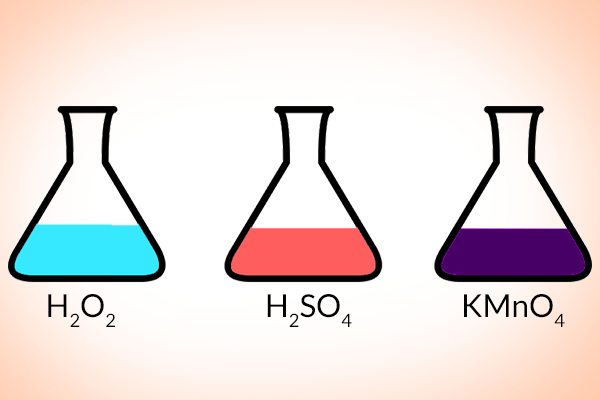Potassium permanent hydrogen peroxide and sulfuric acid (kmno4 h2o2 h2so4) are accessible in nearly all chemical laboratories around the world. KMnO4 and H2O2 react mainly in the medium of H2SO4. To balance the redox reaction, we use the ion-electron technique.
Hydrogen peroxide reacts with potassium permanganate and sulfuric acid (KMnO4 H2O2 H2SO4)
The reaction is an electron exchanging reaction. The reactants in this reaction give and take a certain amount of electrons to make some product. Here, in this chemical reaction, the KMnO4 and H2O2 play the main role, as they exchange the electrons. On the other side, the sulfuric acid (H2SO4) just makes a suitable reaction environment. Since there is electron exchange takes place, we can understand that the oxidation number of the reactants must change. Therefore, the reaction equation in concern is an oxidation-reduction reaction equation.
H2O2 + H2SO4 + KMnO4 = O2 + H2 + MnSO4 + K2SO4
or, After balancing the Redox reaction
5H2O2 + 3H2SO4 + 2KMnO4 = 5O2 + 8H2O + 2MnSO4 + K2SO4
As we talked in the above, the reaction is an Oxidation-Reduction reaction, therefore, by using the ino-electron method we can easily balance the this reaction.

Balancing the redox reaction by ion-electron method
The skeleton reaction for the redox reaction of Hydrogen peroxide potassium permanganate and sulfuric acid (kmno4 h2o2 h2so4) is-
H2O2 + KMnO4 + H2SO4 = O2+ H2O + MnSO4 + K2SO4
If we carefully notice the above reaction, one of the reactants H2O2 releases an electron and another reactant KMnO4 accepts the electron. Therefore, in this reaction the H2O2 acts as the reducing agent, on the other side, KMnO4 acts as the oxidizing agent.
Here,
The Oxidizing agent: KMnO4 or after excluding the spectrator ion, MnO4-1
The Reducing agent: H2O2 or after excluding the spectrator ion, O-1
Reduction Half Reaction
The oxidizing agent, KMnO4, or after excluding the spectator ion, MnO4-1 takes up five electrons which are released by the reducing agent, H2O2, or after excluding the spectator ion, O-1, agent present in the reaction. After accepting the electrons oxidizing agent, KMnO4 gets reduced by the reducing agent, H2O2.
⇒ MnO4 -1 + 8H+ +5e– = 4H2O + Mn2- … …. … … (1)
Oxidation Half Reaction
As we all know the oxidation-reduction reaction is a simultaneous process, which means when the reduction half-reaction takes place, at the same time, the oxidation half-reaction also occurred. Here, in this reaction, the reducing agent, H2O2 releases one electron for each oxygen atom and gets oxidized by the oxidizing agent, KMnO4.
⇒ 2O-1– 2e– = O2 … … … … (2)
Now, in the reduction half-reaction, five electrons are consumed, on the other hand, in the oxidation half-reaction, there are two electrons released to produce an oxygen molecule. To get the balanced full oxidation-reduction reaction we must multiply the oxidation half and reduction half-reaction with the corresponding number and add them together.
So, equation (1)x2 + (2)x5,
2MnO4 -1 + 16H+ +10e– = 8H2O + 2Mn2-
10 O-1– 10e– = 5O2
⇒ 2MnO4 -1 + 10 O-1 + 16H+= 2Mn2- + 8H2O +5O2
At this stage we add necessary ions and radicals to the above ionic form of the full redox reaction,
⇒ 5H2O2 + 3H2SO4 + 2KMnO4 = 5O2 + 8H2O + 2MnSO4 + K2SO4
Therefor, the balanced redox reaction is-
⇒ 5H2O2 + 3H2SO4 + 2KMnO4 = 5O2 + 8H2O + 2MnSO4 + K2SO4
Follow us on Twitter, Facebook, Linkedin and Tumbler
Read more
K2Cr2O7 + FeSO4 + H2SO4 = Cr2(SO4)3 + Fe2(SO4)3 + K2SO4 + H2O


Leave a Reply